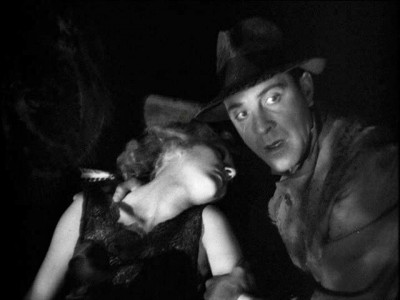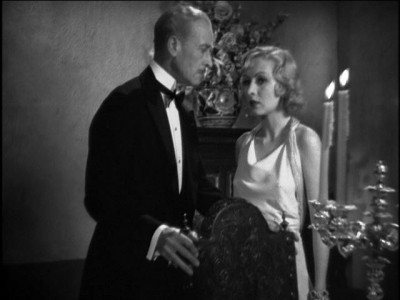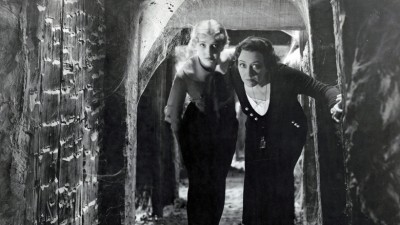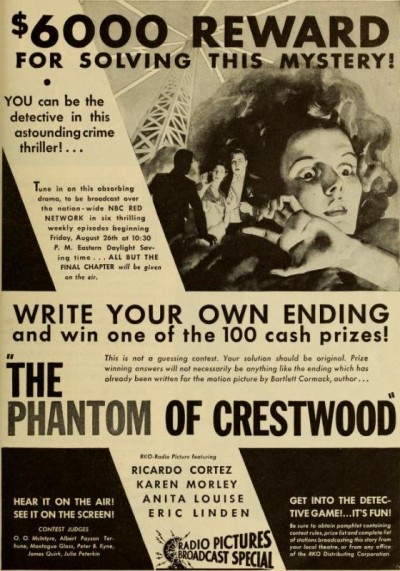
The Phantom of Crestwood (1932) is one of those odd little movies that used to get shunted into position to pad out TV horror packages — probably because its title gives off a horror movie vibe. For that matter, so do large sections of the film, but it’s really more of a murder mystery than an outright horror film — albeit, a murder mystery set mostly in an old dark house cut off from everything by a landslide (courtesy of the inevitable thunderstorm). There are secret passages, a ghostly white face and some pretty gruesome murders. It wasn’t much of a stretch to call it horror, I suppose. Back in those days, the film was shorn of its original opening — an opening that firmly places the movie in the realm of the “stunt” picture. And what a stunt it was, too. The film — as the opening makes clear — is based on an actual radio serial, but this was a different kind of radio serial: It lacked an ending. With the film, the idea was that you had to do more than go see the movie to find out whodunit. Oh, yes. There had been a contest where listeners were invited to submit their solution to the radio mystery, and it seems you had to go see the movie to find out whether or not you won.
The whole thing sounds silly — but dammit, there was a contest! There’s even a Photoplay ad still around to prove it — assuring us of $6,000 in prizes (spread out over 100 prizes), warning us that the actual ending had already been written, and providing a list of low-rent writer judges (along with Photoplay publisher James Quirk, who presumably didn’t do any judging since he handed in his dinner pail before the show aired). Reportedly, one Grace Morris Price took the top prize of $1,500. That’s all just icing on the film itself, and I don’t think it bothered any of us who stumbled across the picture years ago when the contest intro wasn’t included on the TV prints. Now, it merely adds a quaint curio value to a film that has long struck me as just about the closest the movies ever got to capturing the feeling of reading a creepy old mystery novel.

The film stars Ricardo Cortez — who played the movies’ first Sam Spade the year before in the original version of The Maltese Falcon. Cortez was supposed to be the new Valentino — which is why his name was changed from Jake Krantz to the more exotic sounding Ricardo Cortez. The name change did nothing to hide the fact that Cortez was pure New York and he sounded like it. His career never really took off and he’s little remembered today. He may in fact be best known as the actor about whom almost no one who ever worked with him said a kind word. That sort of aura actually works in his favor here where he plays a shady character calling himself “Farnesbarns,” but who in reality is a gangster named Gary Curtis shadowing and trying to retrieve some letters from a compatriot high-end call girl, Jenny Wren (yes, that’s really the character’s name), played by the sexy Karen Morley (more famous today for being a victim of the McCarthy blacklist due to her leftist activities).

The whole plot revolves around Jenny’s plans to blackmail a cadre of her former…er, clients so that she can retire in luxury with her seemingly lesbian maid, Carter (Hilda Vaughn). At the same time, her improbably innocent sister, Esther (Anita Louise), is planning to marry the nephew (Matty Kemp) of one of her old flames (H.B. Warner —yes, even Cecil B. DeMille’s Jesus has been sampling Jenny’s wares) — at whose ancestral home most of the action takes place. Considering Jenny is putting the screws to the men invited to the house, it comes as no great surprise that she’s soon murdered. And it just so happens that Farnesbarnes/Curtis and his boys are on the spot when it happens — just before access to the house is cut off. Realizing that the cops are apt to save themselves a lot of trouble by nabbing him (especially with all the wealthy and powerful suspects on tap), Curtis opts to solve the murder himself. The results are actually a very solid mystery with flashes of genuine horror and a very unusual (especially for the time) flashback structure involving swish pans from scene to scene (rather like those in 1933’s better known The Kennel Murder Case).

The film boasts a terrific atmosphere — the misty exteriors at the end are still striking and unusual — and a smart, very pre-code screenplay. (Actually, the ending itself is one the production code would not have sanctioned.) There’s never any doubt as to just what Jenny Wren’s profession is — nor that her customers are from the very cream of Los Angeles society. (“What a bunch of mangy pillars of society,” sneers “honest” gangster Curtis at one point.) Some of the dialogue is pretty choice, too, such as when Jenny offers to loan Esther some clothes and is told, “I don’t like those black things you wear.” “What a shame — a lot of other people have,” responds the world-weary hooker without a heart of gold. For that (and a lot of other reasons), The Phantom of Crestwood ought to be a lot better known than it is.
The Thursday Horror Picture Show will screen The Phantom of Crestwood Thursday, Feb. 21 at 8 p.m. in the Cinema Lounge of The Carolina Asheville and will be hosted by Xpress movie critics Ken Hanke and Justin Souther.



Before you comment
The comments section is here to provide a platform for civil dialogue on the issues we face together as a local community. Xpress is committed to offering this platform for all voices, but when the tone of the discussion gets nasty or strays off topic, we believe many people choose not to participate. Xpress editors are determined to moderate comments to ensure a constructive interchange is maintained. All comments judged not to be in keeping with the spirit of civil discourse will be removed and repeat violators will be banned. See here for our terms of service. Thank you for being part of this effort to promote respectful discussion.